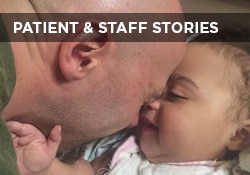This website uses cookies so that we can provide you with the best user experience possible. Cookie information is stored in your browser and performs functions such as recognising you when you return to our website and helping our team to understand which sections of the website you find most interesting and useful.

Susan E. Mazer, Ph.D. Blog
Thoughts and ideas on healthcare
Hi, and welcome to my blog! I'm Susan E. Mazer -- a knowledge expert and thought leader on how the environment of care impacts the patient experience. Topics I write about include safety, satisfaction, hospital noise, nursing, care at the bedside, and much more.
5 Steps to Optimize the Patient Experience
March 21, 2014
 It’s time that we move from hypothesizing about the ideal patient experience to actually taking personal responsibility for making it happen. But how do you start? Here are five simple steps:
It’s time that we move from hypothesizing about the ideal patient experience to actually taking personal responsibility for making it happen. But how do you start? Here are five simple steps:
1. Get honest
This is not easy. Our capacity as human beings to rationalize and right a sinking ship is stunning. What I mean by honest is no less than the rigorous honesty called for in the 12 steps of Alcoholics Anonymous.
Look around and become literal in your description of what you see. Listen without trying not to hear, but listen with the intention of owning what floats around in the auditory environment that no one wants to or should hear.
By doing this, you can begin to understand what patients and their families hear and see. And, then be compassionate with your staff if they have not seen or heard what you’ve heard and seen — after all, it took you until now to do so.
2. Get honest with yourself
The level of rationalization that we master is matched only by the level of fibs we tell ourselves. Self-honesty is foundational to organizational integrity.
And, patients and families know a cover-up or a “story” when they hear it. Many of us tend to lie to ourselves before we rationalize to anyone else. We accept the unacceptable by telling ourselves “it is not that bad” or “we have not gotten a complaint about this yet.”
By getting honest with ourselves, what we tolerate becomes intolerable because what we “put up with” is very different than that we are proud of. If we are not willing to hear someone else’s truth, how do we accept and come to our own?
It’s also critical is to accept and encourage honesty in others. Again, be compassionate with your staff and help lead them through the process.
3. Be urgent: fix what is broken
While I was doing a staff-development program on creating healing environments at a hospital that shall be unnamed, the staff complained all day about the doors on nurse servers that made noise when they closed. An annoying click.
And, they determined that when the doors were open (which was the expedient solution to avoiding the annoying click), these servers, which were part of a fire wall, amplified every discussion that took place next to them not only to the patient’s room, but also to other rooms. Further, nurse reporting was done next to the open nurse server.
I asked how long this situation had existed. “About 20 years,” was the response. When I asked was required to close them, the answer was “Using one’s thumb to close it very carefully to make the least noise.”
I must have looked surprised. Later that day when we toured the units, all the nurse servers were closed. Every one of them.
It only took a couple of decades to have an open, honest discussion about an ongoing annoying noise and subsequent breach of speech privacy and then only a couple of hours to take find and implement a solution.
The cart that squeaks, the sounds of inconsiderate laughter or conversations, the not quite clean enough public bathrooms that visitors try to ignore but never forget — all of these or any of them can contribute to the angst and anxiety that can contaminate the whole unit.
Wheelchairs and gurneys that border corridors are also an accident waiting to happen. Clutter equals risk; tolerated and avoidable risk is intolerable.
Do everything possible to urgently deal with what is clearly not acceptable — no delay, no forms to fill out. Just fix it. If you do this, risks that are often easily resolved can be eliminated.
4. Celebrate the heroes
“Ordinary people who do extraordinary things.” There are clearly people in our hospitals in every department who carry the burden of the patient experience in their hearts. They do intentional acts of kindness.
They would not think of passing a lost visitor, sad child, lonely patient sitting by a window, or co-worker who appears distraught without acknowledging them, without offering some kind of support. Acknowledgment is undervalued. It is saying, “I see you” without judgment or need for explanation.
It is about being human together. It is about being present while entrusted with the health of another. Heroism in this sense can be contagious.
Model intentional acts of kindness, compassion, and empathy. If you don’t, what kind of expectations can you reasonably have of others? Be a hero among heroes.
5. Appreciate what is right
Appreciative inquiry is a model of transformation that begins from strength and ends with stronger. It begins by taking stock of all that is working and what is the best in our organizations and its individual members.
It says that being strength-based is far better than investing in weaknesses. This is not a conflict with acknowledging what can immediately be improved or remedied.
It is our strengths that allow us to make sure changes with confidence and expedience. And, it demands that we have high expectations of others and ourselves when anything else puts someone’s life on the line.
It says that strength comes from honesty and integrity. Commitment is what pulls us to the other side of brokenness. It’s not about being perfect, but celebrating what is possible and happening every day.
Final thoughts
These steps are my steps. Far from original, they borrow from lots of other lists, experiences, and expertise. And, they are not absolute. But neither is the patient experience.
Also, they are contingent upon each other. Missing a step sacrifices them all.
Each step demonstrates our proactive commitment to our patients and those who care for them in a different way. They each call for simplicity, not a myriad of complexities that often hide the obvious and paralyze all action.
Make your own list. Borrow from whatever or whoever has influenced you positively, and, of course, from your own experience. But keep to no more than 5 steps. Any more and we may not hold on to any of them.
And remember, it’s not about specialization. The more details you add, the less opportunity for success. Make each step totally simple and totally doable.
Then, work your 5 steps every day, in all of your affairs. Make the list public to make yourself accountable. Make changes as you learn what works.
Your experience becomes the patient experience which becomes the organizational and community experience. Model the best and the best is what you shall achieve. And, the best is what all patients deserve.
P.S. If you like this post, please do me a favor and share on LinkedIn, Twitter, Facebook, etc. Also to get automatic notices when a new post is published, subscribe (upper right). No spam – just great content. Thanks!










